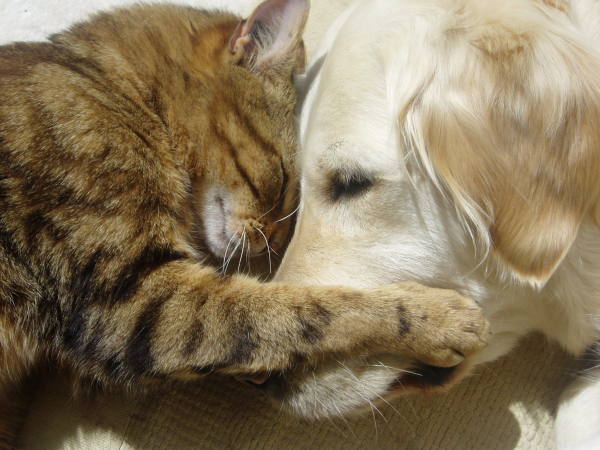If you have a dog and are going to get a cat (or vice versa), then getting them right is literally a matter of health and safety. If you just bring a new pet into the house and leave the animals in the same room, it will not end well – not now, not later. As the owner, you must prepare in advance how to introduce the dog to the cat and teach them how to get along with each other.
The Perfect Friend for Your Pet

Everyone knows the saying “Live like a cat and a dog”. So that for you it does not become an everyday reality, think about whether you should even take a dog to a cat (or a cat to a dog) and, if so, what kind of pet. Ideally, you should take into account the individual characteristics and characters of both animals. In particular, pay attention to the following aspects:
Have you noticed that your dog growls at cats or barks uncontrollably at them? Or chasing them, showing aggression, driving them into a corner, grabbing – in other words, behaving rudely, regardless of whether they are street cats or your friends’ pet? In this case, it is better to completely abandon the idea of making friends with a dog and a cat. The rule works in the opposite direction – if a cat hisses, attacks, or, conversely, runs away or hides at the sight of a dog, then most likely he will not be delighted with living together with her.
If you still want to take the risk and have a second pet under these initial conditions, proceed with extreme caution and caution. It may be better in your situation to take a cat that has previously lived with dogs.
Does your dog like to chase moving objects? Then you shouldn’t take an energetic cat who loves to run and jump on others. A cat that is too shy and runs away at the sight of any danger will not suit you either. In both cases, the dog will chase him around the house forever. The optimal choice would be a calm and balanced animal, which will not be worn either for the sake of play or out of fear.
If your dog enjoys rough play, it is best not to have a kitten and an elderly cat, as it can injure them. An adult cat that can fend for itself is the best choice. The ideal pair is a frisky, playful cat and an equally playful dog (but playing carefully).
If your first pet is elderly and calm, then the same animal is best suited for him. Do not take someone who will irritate, frighten, or otherwise bother your pet.
If you have a dog and are planning to take a cat, it is best to train him to ignore felines in advance during walks.
How to Introduce a Dog and a Cat: a Step by Step Method

Regardless of whether you add a cat to a dog or vice versa, their first acquaintance is a very important stage. The tips below will help you make friends with animals as calmly as possible.
Choosing the best place for the first meeting
The main rule is not to take your cat/dog to a shelter or nursery where you plan to take a second pet. Bringing your dog to a cat shelter will only stress the locals. Likewise, you should not introduce a cat to her future friend in a dog kennel. Ideal acquaintance should take place under the control of the owner, in calm conditions for both animals – that is, in your house or in your apartment.
In principle, a cat should not be brought to a place where many animals are kept, no matter whether it is a shelter, a nursery, or another organization. Such visits may be unsafe for her physical and psychological health.
Some breeders want to see how their pet treats cats in general before adopting one. But this is not a reason to take your dog with you to a cat shelter. First, have pity on its inhabitants. Secondly, the behavior of a four-legged friend in a shelter may not reflect at all how he will behave with a cat at home.
If you want to conduct an experiment, it is better to ask the shelter staff if they have balanced cats with experience with dogs, with whom you can introduce your four-legged friend – under your supervision and, most likely, under the supervision of a shelter worker. If it is impossible to organize such an acquaintance, talk to friends – maybe they have a cat that is not afraid of dogs, and they will agree to participate in your experiment. If this plan did not work, the last option remains – take the cat you originally wanted to have, bring it home and make your first acquaintance there.
Separating the Pets
So, you now have both a cat and a dog at home. What to do next? Monitor their communication carefully! The process of their full adaptation to each other can take several months, or maybe a few days. One way or another, do not move the animals right away – first, give both pets time to get used to living in the same area.
When you bring the second four-legged friend into the house, the first should be isolated – in a cage or in a closed room. Thanks to this, you will allow the new settler to settle down more calmly.
For several days, alternately give freedom of movement to one or the other animal. This way they will gradually learn each other’s scent.
If during periods of “feline freedom” a locked dog barks uncontrollably or loosens the cage/door and this behavior continues for more than 2 days, the first acquaintance is unlikely to go smoothly. You will probably need the help of a specialist who prepares the dog.
To help the animals get used to each other’s smell, first stroke one, and then let the other sniff you, and vice versa.
Make sure that neither animal eats from another’s bowl – this will lead to unnecessary competition for territory. Consider the option that the bed, water, and food of the cat are not on the floor, but on a dais, for example, on the windowsills – this way you will breed pets at different levels of the apartment.
When there is no one at home, one of the animals should always be in a cage or another room. Don’t let them contact you without your supervision.
When both begin to behave calmly, the cat begins to eat normally and calmly uses the tray, you can proceed to the next step.
Introduce on a Leash
Before the first face-to-face meeting, the cat should trim its claws in case it suddenly tries to scratch the dog. And with the latter, it is recommended to take a walk just before the rendezvous and feed her.
Moment of Truth: Place the animals in the same room at the same time, but keep the dog on a leash. Pass the initiative to the cat – if she wants, she will approach your second pet. Pay close attention to the behavior of both! If the dog barks at the cat and cannot calm down, or if the cat is showing aggression or fear, go back to step 2 and continue.
Before meeting on a leash, you can enter an intermediate stage – put the dog in the cage and let the cat enter this room. There is a good chance that sooner or later she will want to approach the dog, and their reaction to each other will show whether they should continue to communicate or until it is better to return to step 2.
Do not bring pets to each other forcibly and do not force them to anything. It is better if the “face-to-face meetings” are brief at first. The cat should have a place where it can run away if necessary, for example, elevations – a shelf, a sideboard. Optimally, if the door to the room is open – then, feeling danger or discomfort, the cat will simply leave the room.
Try to reinforce the communication with something positive – for example, give treats (for both of them!) Or pet both pets when they are in the same room. You can also treat them to treats after the rendezvous if the meeting goes well. Positive incentives will strengthen the friendship.
Continue talking on the leash until the dog calms down and ignores the cat and the cat starts eating and walking normally again in the litter box.
The first co-op games should also take place under your supervision. Stop overt aggression or potentially dangerous behavior.
Step 3 lasts until both pets are relaxed around each other. Prepare for the fact that this can take quite a long time.
Allowing animals to contact without your control
You can only leave animals alone when they have spent enough time together under your supervision (a month or more) and you are 100% sure that they will not harm each other.
Tip: If the dog is staring at the cat or at the door behind which he is sitting, try to distract him. Use treats, commands (speak with a happy tone), or gently pull your pet aside with a leash. Once the dog is away from the cat, try treating it to a treat. If she ate the treat, repeat the process. Continue until she stops following the cat or the door.
Warning signs

If the dog continues to closely follow the cat or the door, completely ignoring you, or suddenly bounces on him, as soon as he moves, such cohabitation can end in disaster. If you originally owned a cat, consider another dog. If you have a dog, you shouldn’t get a cat.
If a dog growls, bounces, or shows other signs of aggression towards a peacefully lying cat, they are unlikely to make friends. It is the same if the cat offends the dog, which behaves completely calmly. If you absolutely need to make friends with such animals, you will have to contact a specialist.
If your dog behaves ambiguously around a cat that hisses and paws, then try to find a calmer cat. If you introduced your dog to different animals, but it continues to conflict with everyone, it is better not to have a second pet.
If the cat is behaving aggressively, take a break and continue on another day. It might be worth trying to breed her with another animal. On the other hand, a cat constantly hissing at dogs is unlikely to want to cohabit with them. Of course, she can tolerate them, but she will not be happy from this life. Should I torture her?
If the cat has stopped eating, drinking, going to the litter box, and approaching family members, she is unhappy. You should look for another pair for her or contact a specialist.
